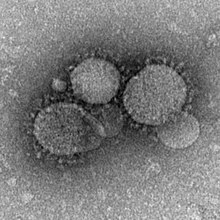Middle East respiratory syndrome coronavirus
| MERS-CoV | |
|---|---|
 |
|
| MERS-CoV particles as seen by negative stain electron microscopy. Virions contain characteristic club-like projections emanating from the viral membrane. | |
| Virus classification | |
| Group: | Group IV ((+)ssRNA) |
| Order: | Nidovirales |
| Family: | Coronaviridae |
| Subfamily: | Coronavirinae |
| Genus: | Betacoronavirus |
| Species: | Middle East respiratory syndrome-related coronavirus |
The Middle East respiratory syndrome-related coronavirus (MERS-CoV), or EMC/2012 (HCoV-EMC/2012), is a novel positive-sense, single-stranded RNA virus of the genus Betacoronavirus.
Initially called novel coronavirus 2012 or simply novel coronavirus, it was first reported in 2012 after genome sequencing of a virus isolated from sputum samples from a person who fell ill in a 2012 outbreak of a new flu.
As of July 2015, MERS-CoV cases have been reported in over 21 countries, including Saudi Arabia, Jordan, Qatar, Egypt, the United Arab Emirates, Kuwait, Turkey, Oman, Algeria, Bangladesh, Indonesia (none were confirmed), Austria, the United Kingdom, South Korea, the United States,Mainland China, Thailand, and the Philippines. MERS-CoV is one of several viruses identified by WHO as a likely cause of a future epidemic. They list it for urgent research and development.
The virus MERS-CoV is a new member of the beta group of coronavirus, Betacoronavirus, lineage C. MERS-CoV genomes are phylogenetically classified into two clades, clade A and B. The earliest cases of MERS were of clade A clusters (EMC/2012 and Jordan-N3/2012), and new cases are genetically distinct (clade B).
MERS-CoV is distinct from SARS coronavirus and distinct from the common-cold coronavirus and known endemic human betacoronaviruses HCoV-OC43 and HCoV-HKU1. Until 23 May 2013, MERS-CoV had frequently been referred to as a SARS-like virus, or simply the novel coronavirus, and early it was referred to colloquially on messageboards as the "Saudi SARS".
Over 1,600 cases of MERS have been reported by 2015 and the case fatality rate is >30%. 182 genomes have been sequenced by 2015 (94 from humans and 88 from dromedary camels). All sequences are >99% similar. The genomes can be divided into two clades - A and B - with the majority of cases being cased by clade B. Human and camel strains are intermixed suggesting multiple transmission events.
The first confirmed case was reported in Saudi Arabia in 2012.Egyptian virologist Dr. Ali Mohamed Zaki isolated and identified a previously unknown coronavirus from the man's lungs. Dr. Zaki then posted his findings on 24 September 2012 on ProMED-mail. The isolated cells showed cytopathic effects (CPE), in the form of rounding and syncytia formation.
...
Wikipedia
